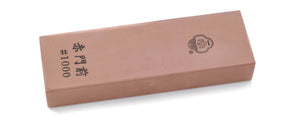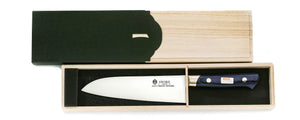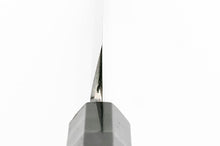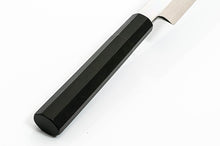
- Blade:VG10 Stainless Steel
- Honyaki: A Forging Process which is similar to traditional Japanese sword making technique. It makes the knives hard, sharp and have a high edge retention.
Mirror Finish
The blade with luster that evokes a sense of luxury. Also, it is more resistant to rust than other surface finishes.
| Product number | Actual Blade Length (mm) | Full Length (mm) | Total Weight (g) |
|---|---|---|---|
| 1svh-240 | 235 | 380 | 150 |
| 1svh-270 | 260 | 415 | 215 |
| 1svh-300 | 290 | 450 | 220 |
| 1svh-330 | 320 | 485 | 280 |
| Blade | Material Name | Handle |
|---|---|---|

Single Edged |
VG-10 | Ebony octagonal handle |

Yanagiba (Sashimi Knife)
Yanagiba knives are mainly used for cutting Sashimi. The sharpness and edge geometry is of the utmost important with a Yanagiba, as a dull knife will damage the delicate fibres of the fish. The blade is long, slender, thin and sharp for cutting sashimi in one stroke. In addition to cutting sashimi, this knife is also used for pulling the skin. Professionals use long Yanagiba knives with blades around 300mm. For home use, Yanagiba knives with a blade of around 210mm are popular.
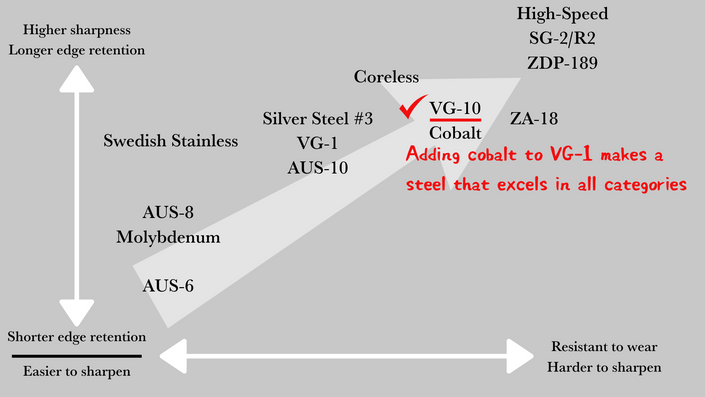
VG-10
Adding cobalt to VG-1 stainless steel's composition increases its wear resistance and tenacity. The resulting VG-10 stainless steel is also easy to process, making it easy to create well-balanced kitchen knives.
Stainless Steel
VG-10 is one of the most popular stainless steels used in kitchen knives today and is made from carefully selected and high-purity raw materials with good machinability. VG-10 is both hard and tough, while staying easy to resharpen.This combination of factors gives the highly efficient VG-10 a strong advantage over other steels in its field.

Ebony Handle
Ebony is a highly durable wood, which specializes in giving good balance to a knife. Due to both its fascinating appearance and durability, it is known as a luxurious material in Japan. The wood's unique grain naturally becomes more comfortable in your hand as you continue to use it.

Honyaki
Honyaki, meaning "true forging" in Japanese, represents the highest grade of forged Japanese kitchen knives. Forged with only the cutting steel, honyaki knives are super sharp with unmatched edge retention if correctly made. These knives must be handled carefully, as they break easily during production and chip quickly if incorrectly used. Only a few blacksmiths in Japan with great skill, concentration, and physical ability can make the even more specialized Mizu-honyaki; the process of cooling the blade with water to force an instant temperature change during quenching, resulting in a knife without equal when it comes to hardness.

Optional Engraving
Optional Engraving Service
Sakai Ichimonji provides complimentary engraving using either Japanese Kanji or English Alphabet. Please specify your preference. For details, please visit here
A knife store that has supported the history of knives and food culture in Japan.
It has been 600 years since the birth of swordmaking in the Sakai region of Japan. Sakai Ichimonji Mitsuhide's and it's craftsmen continue to build on that legacy by producing the finest blades in Japan.
This is where the culture of completing a dish of sashimi by "just cutting" and the culture of expressing sharpness as "taste" was born.
For 70 years, we have been connecting the spirit of Sakai's craftsmen with the passion of chefs in Osaka's kitchen equipment shopping district, known as the kitchen of Japan.
We are very happy that our knives can be used by people all over the world.
Precautions
After use, wash off any dirt and wipe thoroughly with a dry cloth to remove any moisture. This product is not for use with frozen foods.This product is handmade, so each piece will be different. Please use the weight and length listed as a guide. Each material is natural and may vary in color. It is not the same as the picture.We take great care with our inventory, but in the unlikely event that we are out of stock, we will contact you by email to let you know.



























